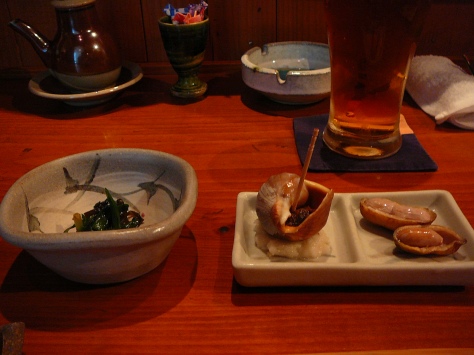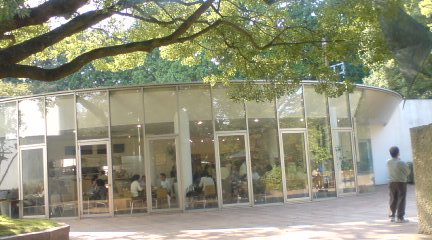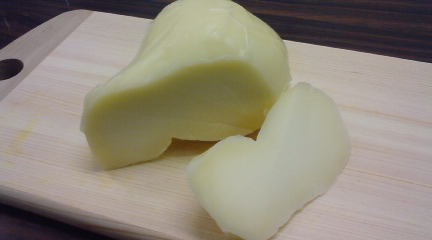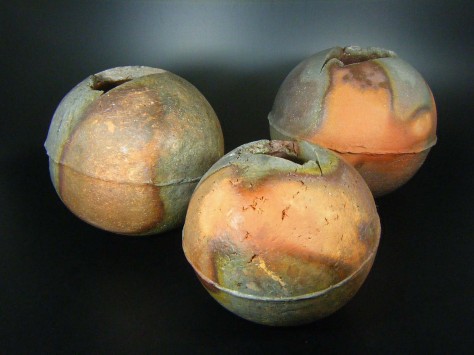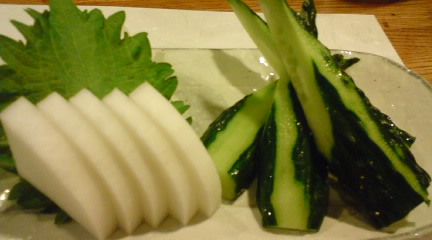
Foodbuzz never asked me for such an article. I just wrote it first out of concern for some of my Foodbuzz Friends!
It was Lou-Ann‘s surprise in particular which originally prompted me into investigation to back up knowledge acquired though many years spent in this great country, Japan. It is the second time I publish this article as it has become more of actuality and new information has been made available.
I use the word “great” when applied to Japan for a simple reason:
Japan is the one country which most extensively conducts and sponsors research and development of fish stocks.
This country has also come up with some momentous discoveries related to the fishing environment:
-Japanese fishermen south of Kyushu Island discovered that planting trees on small islands increased manifold the amount of vegetal plankton carried into the surrounding sea resulting in an immediate increase of the fish population.
-Japanese researchers found out that building small pyramids on the sea floor with concrete or plastic (a beneficial dumping at last?) blocks attracted corals, sea anemones, seaweed and shellfish, thus creating a food chain for fish. Such pyramids will surely prove more beneficial to mankind than all the Egyptian pyramids put together!
They have also realised that dragging out sunk ships was not needed as the same lost vessels were populated by all kinds of marine life!
In the north of Japan crab stocks are been replenished by simply sinking giant scaffolds to the bootom of the sea, thus providing the delicious critters with the subtarreanean geography they love best!
Sakura ebi/Cherry shrimps fishermen in Yui (Shizuoka Prefecture again!) syphon the shrimp out of the nets before opening and releasing all other marine lie safely back into the sea!
The Japanese have been (unjustly) accused of emptying the seas. Actually Spain holds the world record for fish catch and consumption.
I already have written an article on whale meat. I find it galling that Japan is villified for eating whale meat by the very countries which depopulated the globe of sea-mammals in the 19th Century: US, Canada, Russia, Australia and New Zealand (alright, Great Britain for the last two maybe!) in the Pacific Ocean. US, Canada, Norway, Great Britain, France, Spain and Russia in the Atlantic Ocean. And most of them again in the Arctic and Antarctic Oceans. What do you think Commodore Perry was before he was delegated to order Japan to “open its doors”?
This country is repeatedly thrown into the same basket of evils. I was recently “told off” because the Japanese kill sharks for their fins before throwing the dead fish back into the sea. Sorry, mate, but you will have to ask the Chinese! The Japanese eat the whole fish when they catch it and make kamaboko from it!
It could go on and on, but this was never the real purpose of this article.
Now, to illustrate and justify the heading of this posting, here is a list of the fish and seafood raised in Japan as opposed to being caught in the wild:

Blue Fin Tuna/Honmaguro
Yes, you read it, Blue Fin Tuna! After 23 years of experimentation, a Kyushu fishmonger has finally succeeded in producing the fish from natural mating inside giant offshore sea parks. The fish is already sold over the counter at supermarkets.
No later than last year the Tokai Marine University in Shimizu, Shizuoka City (I live in a great place, don’t I?) also succedein a more sientific manner the raising of the same tuna from the egg, promising that domestic Blur Fin Tuna will roam the same waters in Suruga bay as their wild cousins!
With a ban on tuna fishing in the Mediterranean Sea being pushed through legislation by the EU, Japan will find itself one day in the rich position of actually exporting tuna!

Big-eyed Tuna/Mebachi Maguro
Human-raising Research is conducted and nearly brought to fruition.

Albacore Tuna: Kihada Maguro
Human-raising Research is conducted and will soon be sucessful.
Note:
Indian Ocean Tuna/Indo Maguro: Human-raising Research is conducted abroad and such fish are imported to Japan.

Yellowtail/Buri
Over 62,000 tons of human-raised fish consumed last year.

Amberjack/Kanpachi
Over 49,000 tons of human-raised fish consumed last year.

Striped Jack/Shima Aji
Over 3,000 tons of human-raised fish consumed last year.

Horse Mackerel/Ma Aji
Over 3,500 tons of human-raised fish consumed last year.

True Mackerel-Japanese Mackerel/Ma Saba
Human raising succeeded and fish are already sold over the counter.

True Sardine-Pilchard/Ma Iwashi
Human-raising Research is being conducted and could created a real revolution as the same fish also become feed for above tuna.

Isaki/Grouper variety-Parapristipona Trilinoatum
9 tons of human-raised fish consumed in Nagasaki Prefecture alone last year. Shizuoka is also coming up with them!

Silver Salmon/Gin Sake
Over 8,000 tons of human-raised fish consumed last year.
Production very fast.

Porgy/Madai
Over 71,000 tons of human-raised fish consumed last year as opposed to 15,000 tons caught at sea.
Al kinds of seabreams are actually on the line.

Seabass/Suzuki
382 tons tons of human-raised fish consumed in Kagawa Prefecture (Shikoku) alone last year.

Sand Borer-Sillago/Kisu
Human-raising Research is being conducted.

Bar-tailed Flathead/Kochi
Human-raising is being conducted.

Ainame/Alexagrammos otakii
Human-raising has succeeded and some fish is already sold over the counter.

Kelp Bass/Kue
A success story in Shizuoka and Nagasaki Prefectures where human-raised fish are already sold over the counter.

Globefish-Tiger Globefish/Tora Fugu
Over 5,000 tons of human-raised fish consumed last year.
Shizuoka is rapidly becoming a major producer, especially inhamana (sea) Lake in the Western part of the Prefecture.

Large Prawn/Kuruma Ebi
Over 1,700 tons of human-raised prawns consumed last year.

Spiny Lobster/Ise Ebi
Human-raising Research is being conducted.

Ark Shell-Bloody Clam/Akagai
Human-raising Research is being conducted.

Gaper/Mirugai
Human-raising Research is being conducted

Large Cockle/Torigai
Human-raising Research is being conducted

Hard Clam/Hamaguri
Very large amounts of half human-raised shellfish consumed last year.
All the clams picke by tourist in Hamana lake have actually been planted young there!

Surf Clam/Hokkigai
Human-raising Research bein conducted

Abalone/ Awabi
32 tons tons of human-raised abalones consumed in Hokkaido and Nagasaki Prefectures alone last year.
Now, knowing the price of such shellfish and the enormous consumption in other countries, it promises to become a very lucrative business!

Scallops/Hotate
Over 270,000 tons of human-raised scallops consumed last year.
The shellffish being hermaphrodite, it will become easier and easier tomake and sell. Here in Shizuoka it has simply become ridiculaoulsy cheap!

Oysters/Kaki
Over 220,000 tons of human-raised oysters + over 35,000 tons of the same out of the shell consumed last year as opposed to 1,600 tons of wild oysters.
Actually soon or later the catch of wild oysters will become strictly regulated as many other shellfish. Poaching both by Japanese and “foreigners” is being fought off in earnest.

Sea Urchin/Uni
7 tons tons of human-raised sea urchin consumed in Hokkaido Prefecture alone last year.

Conger Eel/ Ma Anago
Human-raising Research is being conducted

Common Eel/Unagi
Over 21,000 tons of human-raised fish consumed last year as opposed to 610 tons caught in the wild.
In some places, notably Mishima City, eel restaurants refuse to serve wild eels.

Oike Conger eel/Hamo
Human-raising Research is being conducted.
The Japanese have also starting research on different varieties of octopus/tako and squids/ika.
Probably more coming soon or later!
RECOMMENDED RELATED SITES:
Warren Bobrow
Wild River Review
Bread + Butter
5 Star Foodie
Frank Fariello
Elinluv Tidbit Corner
Tokyo Terrace
Maison de Christina
Chrys Niles
Comestilblog
Greedy Girl
Bouchon For 2
Please check the new postings at:
sake, shochu and sushi
—————————————-
日本語のブログ
—————————————-























